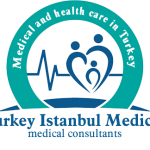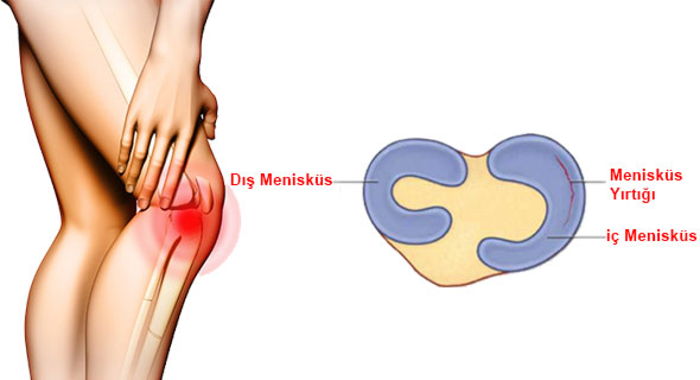Meniscus
The meniscus is one of the most common joint injuries. Meniscus tears in young people usually occur in sports accidents.
These untreated tears can adversely affect the careers of athletes, especially. In the elderly, meniscus, which occurs due to wear and tear of the body, can be treated with various methods. Examination, MRI or diagnostic arthroscopy are used to diagnose the meniscus.
What is the meniscus?
Although the meniscus is known as a disease among the people, it actually represents an important structure that protects the cartilages in the knee area. This structure provides ease of movement in the knees, which is one of the busiest joints in the body.
Roughly speaking, the meniscus, which functions as a hinge between the crotch and thigh bones, consists of two parts in the shape of O and C. Each knee contains a set of these pieces.
The O-shaped structure is called the outer, and the C-shaped structure is called the inner meniscus. The meniscus, which increases the contact surface of the caval and thigh bones with each other, enables a balanced distribution of the body weight on the bones.
In addition, absorbing the shock force that occurs in the knee region as a result of a sudden impact and allowing the intra-knee fluid to spread to the joint cartilages are among the disorders caused by the meniscus.
How Does a Meniscus Injury Occur?
Meniscus tear, which is one of the problems frequently encountered by athletes, can also happen to many people in daily life. Those who carry heavy loads, those who are constantly standing, housewives who are busy with housework and the elderly may face meniscus tear.
This type of injury, which usually occurs when the body weight is given to one side, can sometimes occur even with simple movements such as kneeling, squatting and lifting heavy loads. When the tears and injuries in the meniscus are handled under several main headings, these headings are listed as follows:
Direct Injuries
It covers injuries caused by direct blows to the knee. Falling on the knee, traffic accidents, kicks to the knee cause this type of injury.
Indirect Injuries
It consists of injuries caused by rotation of the trunk above the knee. In such cases, the body performs a rotational movement on the knee while the foot is usually fixed on the ground. While tears in football matches and during skiing are considered as indirect injuries, loss of balance and uncontrolled rotation of the body on the knee can also cause indirect injuries.
Degenerative Injuries
It is considered as injuries caused by deformations in the body due to old age. In such cases, which are especially seen in the elderly, even the slightest blow to the knee prepares the environment for the rupture of the solid meniscus.
What are the Meniscus Symptoms?
- Pain in the knees
- Swelling and stiffness in the knees
- Lock in knees
The first complaints of patients with meniscus tears are usually pain, swelling and stiffness in the knees. Pain in the knees while climbing up and down stairs, sitting up or going up and down slopes begin to give the first signals of damage to the meniscus.
This type of pain and swelling, which is ignored in daily life, can lead to more serious problems in the future. In the next stage, patients face the problem of locking in addition to pain in the knees.
Stuck in the knees while sitting and standing causes the knee to lock in a certain position and then a feeling of ejaculation in the knees.
Meniscus treatment, which is noticed in its early stages, can be performed without the need for surgery. However, in the later stages, it may become mandatory for patients to have meniscus surgery.
How is Meniscus Treatment Done?
The treatment method applied to the patients varies according to the size of the injuries and tears in question. In acute cases, applying ice compresses to the area, keeping the knee higher than the body and resting play an important role in the treatment. Pain and compression in the knees make the daily life of patients very difficult.
For this reason, the patient should be diagnosed as soon as the complaints occur. Appropriate treatment should be started immediately.
Otherwise, the sports activities of the patients are interrupted with daily activities. In addition, untreated tears cause wear on joints and bones at an early age, causing knee arthritis called “gonarthrosis”. Treatment methods used to prevent these problems are discussed under two main headings: exercise, drug therapy and surgical treatment.
Exercise and Medication
In low-grade tears, the damage to the meniscus can be repaired with the medications and exercises recommended by the doctor after the examination and diagnosis procedures.
In addition to these exercises and medications, patients need to rest for a certain period of time. When the meniscus can be healed with physical therapy, sticking to the exercise program given by the doctor is of great importance in the recovery process.
Otherwise, low-grade tears may progress and require surgical treatment. For physical therapy to be effective, an exercise plan of at least 1.5 months may be needed.
Arthroscopy Replaces Open Surgeries
A new era is beginning with the developing technology in meniscus surgery.
With a special technique called arthroscopy, very small holes are made in the knees of the patients.
An optical device with a camera is inserted through these holes.
The area shown by the device is reflected on the screen and the damaged area can be seen clearly.
Removal of the torn part of the meniscus is sufficient for treatment.
Arthroscopy, which replaces the open surgeries used in the past, does not cause scars and stains.
In addition, this technological method allows the patient to get up and return to daily activities in a short time without wasting time.
After the procedures without incision, the patients do not have to worry about dressing.
After surgery, the vast majority of patients recover without the need for physical therapy.

